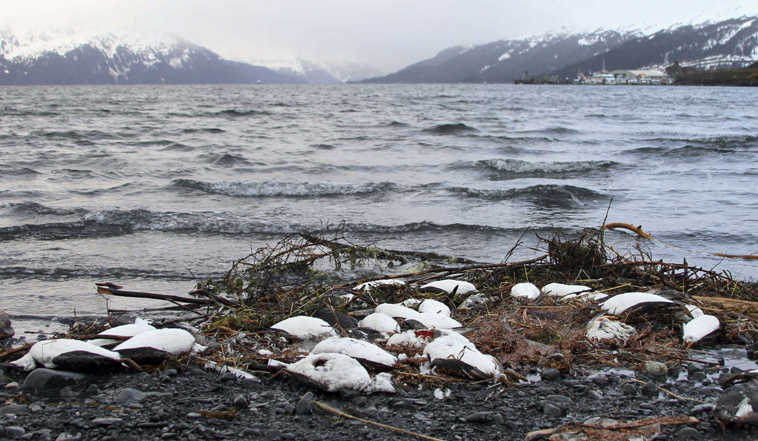ANCHORAGE — A preliminary investigation into the massive die-off of common murres, one of the Northern Hemisphere’s most abundant seabirds, off Alaska’s coast is revealing gaps in basic information on North Pacific waters and the wildlife that inhabit them.
Federal scientists say the mortality may reach the hundreds of thousands. Emaciated common murre carcasses began washing ashore on Alaska beaches in March. No one knows why common murres appear to be starving. Speculation is hampered by unknowns in common murres’ winter diets, the habits of their prey, and conditions in waters far from shore, their preferred habitat, where it’s notoriously expensive to perform research.
“We know a lot more about what they eat in the summer that what they eat in the winter,” said Heather Renner, a U.S. Fish and Wildlife Service biologist at a presentation last week.
Alaska researchers do not routinely survey forage fish eaten by murres, such as capelin, a kind of smelt, and sand lance, another finger-length silvery fish. Scientists say unusually warm water in the North Pacific may have had an effect on forage fish and the zooplankton eaten by small fish. Murres themselves will eat larger zooplankton such as krill, a small crustacean that floats in the water column.
“The birds have told us something is amiss in the food web,” Renner said. “We desperately need targeted studies on lower trophic levels at the same spatial scale as the bird data. Without these, we can’t disentangle the complex reasons why the birds are starving.”
Three federal agencies, joined by university and private wildlife experts, are analyzing data for a report on the die-off, said John Piatt, a U.S. Geological Survey research wildlife biologist and seabird expert.
Common murres are large by seabird standards and can weigh more than two pounds. They routinely live 20-25 years but have a metabolism rate so high that they can use up fat reserves and drop to a critical threshold for starvation, 65 percent of normal body rate, in three days of not eating, Piatt said.
The Alaska population is estimated at 2.8 million that breed at 230 colonies.
Die-offs have been documented before but not to this degree.
During the first 10 days of January, researchers counted 17,293 dead murres on beaches and 854 more in vessel surveys. Only about 15 percent of carcasses reach shore and only a fall fraction of beaches were surveyed, leading researchers to estimate the deaths will be in the hundreds of thousands.
“What’s unprecedented about this die-off is, first the spatial extent of this die-off, which covers most of southern Alaska,” Renner said. “Second, it represents an extended period of time.”
Carcasses began washing ashore in March and other signs of trouble appeared in the summer. Some colonies thrived in 2015 but at a major colony on remote East Amatuli Island, one of the Barren Islands, murres were not fledging chicks. If stressed, and in the interest of self-preservation, common murre females can chose not to lay an egg.
“In more than three decades of monitoring birds in the Barrens, we’ve never had complete reproductive failure before,” Renner said. “And it wasn’t just there.”
By early winter, starving and disoriented birds were found not only in near-shore waters but as far inland as Fairbanks, 360 miles from salt water. After a fierce winter North Pacific storm the last week of December, 8,000 dead common murres washed ashore at the Prince William Sound community of Whittier.
In the January review of recovered carcasses, Piatt said, birds hatched in 2015 were apparently absent. Body size measurements suggested that many were sub-adults, or less than 5 years old.
Researchers say the die-off may be tied to unusually warm water in the North Pacific. Capelin and sand lance may have fled to cooler water, out of reach of murres.
Biotoxins, created by living organisms, have not been found in murre necropsies, but biologists have not ruled them out. Warmer water can lead to harmful algal blooms that create biotoxins. If detected, they usually show up in animals’ stomach contents and the emaciated murres’ stomachs have been mostly empty, Renner.
If murres already were struggling, the hurricane-force storms of late December could also have prevented them from foraging, according to researchers.

